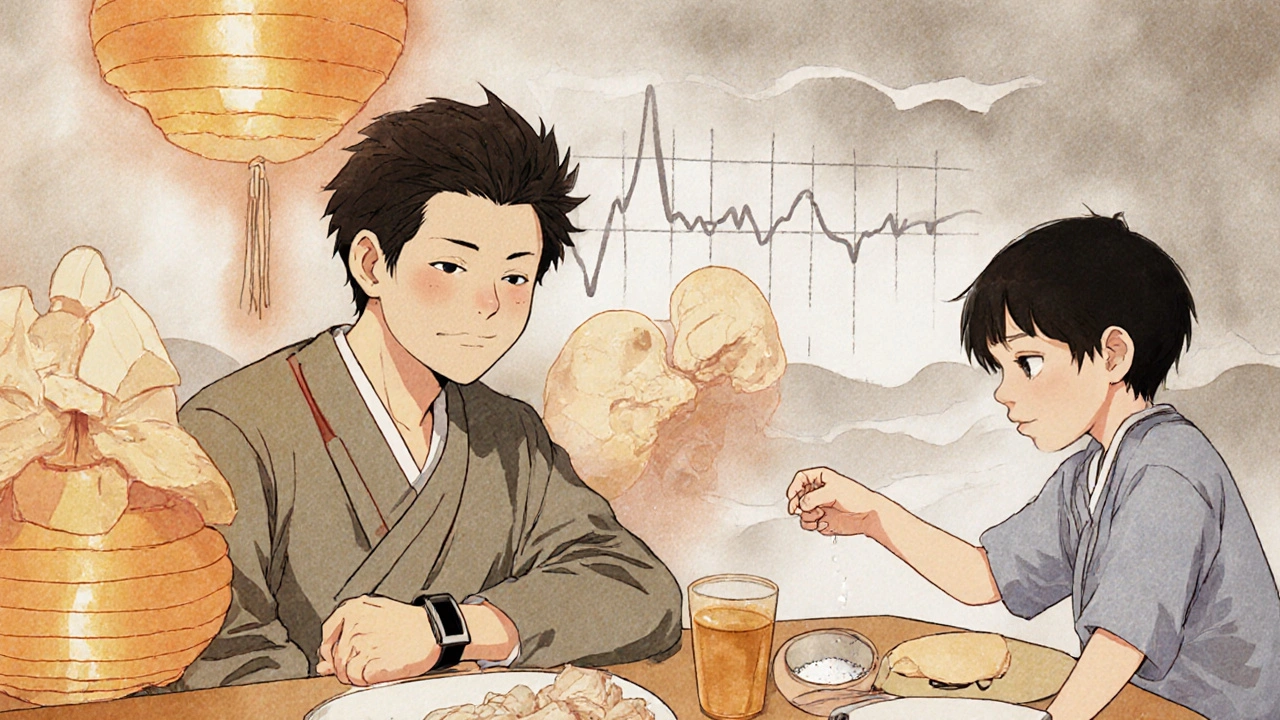Addison's Disease: Understanding Adrenal Insufficiency and Lifelong Steroid Replacement

When your body can’t make enough of the hormones that keep you alive, everyday stress becomes life-threatening. Addison’s disease isn’t just another endocrine disorder-it’s a silent, slow-burning crisis that starts with fatigue and ends in collapse if left untreated. It happens when your adrenal glands, small triangles of tissue on top of your kidneys, are destroyed. Not by cancer. Not by infection. Usually, by your own immune system. By the time symptoms show up, you’ve already lost 90% of your adrenal function. And once it’s gone, it doesn’t come back.
What Actually Happens in Addison’s Disease?
Your adrenal glands make two critical hormones: cortisol and aldosterone. Cortisol manages stress, blood sugar, and inflammation. Aldosterone keeps your sodium and potassium balanced. When these vanish, your body starts to shut down. You feel tired all the time. You lose your appetite. Your blood pressure drops. You crave salt. Your skin darkens-even in places that never see the sun. That darkening? It’s not a tan. It’s your body screaming for help. High levels of ACTH, the hormone that should tell your adrenals to produce cortisol, are now flooding your system. And since your adrenals are dead, ACTH doesn’t stop. It just keeps pushing, staining your skin, your gums, even your scars.
Most cases today are autoimmune. Your immune system mistakes your adrenal tissue for a threat and attacks it. You’ll often find elevated 21-hydroxylase antibodies in your blood. That’s the fingerprint of Addison’s. In the past, tuberculosis was the main cause. Now, in North America and Europe, it’s almost always autoimmune. In parts of Africa and Asia, TB still leads. But the result is the same: no cortisol. No aldosterone. No backup.
How Do Doctors Diagnose It?
It takes an average of 3.2 years for someone with Addison’s to get the right diagnosis. Why? Because the symptoms look like everything else: stomach bugs, depression, chronic fatigue, even eating disorders. A patient might see a gastroenterologist for nausea, a primary care doctor for low energy, or a dermatologist for dark skin. No one connects the dots until it’s too late.
The gold standard test is the ACTH stimulation test. You get a shot of synthetic ACTH (cosyntropin). In a healthy person, your cortisol level jumps within 30 minutes. In someone with Addison’s, it barely moves. A normal response is above 18 mcg/dL. A patient with Addison’s might stay below 5 mcg/dL. At the same time, their ACTH level soars past 50 pg/mL. That mismatch-low cortisol, high ACTH-is the smoking gun for primary adrenal insufficiency.
They’ll also check your electrolytes. Hyponatremia (sodium below 135) and hyperkalemia (potassium above 5.0) are common. Aldosterone is low. Renin is sky-high. These numbers don’t lie. Secondary adrenal insufficiency-caused by pituitary problems-looks different. Cortisol is low, but ACTH is low too. Aldosterone is normal. No dark skin. No electrolyte chaos. That’s why testing matters. Mistake one for the other, and you give the wrong treatment.
Steroid Replacement: The Lifeline
There’s no cure. But there is a lifeline: replacement therapy. You need to take what your body can’t make. For most people, that means two drugs: hydrocortisone and fludrocortisone.
Hydrocortisone replaces cortisol. The standard dose is 15 to 25 mg per day, split into two or three doses. Most take 10 mg in the morning, 5 mg at lunch, and 5 mg in the afternoon. Why not one big dose? Because your body doesn’t work that way. Cortisol naturally peaks in the morning and drops at night. Taking it all at once mimics a rollercoaster. Your body craves rhythm.
Fludrocortisone replaces aldosterone. You take 50 to 300 micrograms daily. It tells your kidneys to hold onto sodium and kick out potassium. Without it, you’ll keep losing salt through sweat and urine. You’ll get dizzy when you stand. Your blood pressure will crash. You’ll feel weak. You’ll need more salt on your food. That’s not a craving-it’s survival.
Some people now get Chronocort, a newer once-daily tablet that releases hydrocortisone slowly. It’s designed to mimic natural cortisol rhythms better. Early studies show 37% fewer cortisol spikes and crashes. But it’s expensive. And not everyone can access it.

The Real Danger: Adrenal Crisis
Medication isn’t enough. The biggest threat isn’t forgetting a pill. It’s what happens when you get sick.
Stress-fever, infection, surgery, even a bad toothache-triggers adrenal crisis. Your body needs three to five times more cortisol. But your adrenals can’t respond. Your blood pressure plummets. You vomit. You pass out. Your skin turns cold. Your heart races. You’re dying. And it can happen in minutes.
One study found primary adrenal insufficiency patients have 8 to 10 crises per 100 patient-years. Infection causes 39%. Gastroenteritis, 25%. Skipping meds, 18%. And if you don’t get treatment within an hour, your chance of dying rises by 3-5% per hour.
That’s why every patient must carry an emergency injection kit. It’s 100 mg of hydrocortisone, ready to inject into your thigh or arm. If you can’t swallow, if you’re vomiting, if you’re too weak to stand-give yourself the shot. Don’t wait for an ambulance. Don’t call for help first. Inject. Then call.
Wear a medical alert bracelet. Every ER in the country should know what to do. But not all do. Many patients report being told they’re “just anxious” or “having a panic attack.” That’s why education is part of the treatment. The Addison’s Disease Self Help Group’s “Sick Day Rules” teach you exactly when to double or triple your dose. If you have a cold? Double. If you have the flu? Triple. If you’re vomiting? Inject. If you’re in pain? Inject. No hesitation.
The Hidden Costs
Hydrocortisone isn’t cheap. Without insurance, a month’s supply can cost $350 to $500. Fludrocortisone is cheaper, but still adds up. Forty percent of patients say they skip doses because they can’t afford them. A quarter ration their pills. That’s not laziness. That’s survival math.
And then there’s the emotional toll. Seventy-eight percent of patients have had at least one adrenal crisis in the last five years-even while following every rule. The fear is constant. You cancel plans because you feel “off.” You avoid travel. You dread the night when your child gets a fever. You’re always one illness away from collapse.
Reddit threads are full of stories: “I had to explain to my boss why I needed to leave mid-meeting because I felt like I was going to die.” “I called my endocrinologist at 3 a.m. because my fever hit 102, and they didn’t answer.” “I had to inject myself in the parking lot before walking into the ER.”

What About Overdose?
It’s not just about taking too little. Taking too much is just as dangerous. Over-replacement with hydrocortisone increases your risk of heart disease, diabetes, and bone loss. A 2021 study found it raises cardiovascular death risk by 44%. Under-replacement? That raises adrenal crisis risk by 200%. The line between life and death is thin. You need to find your sweet spot.
That’s why regular blood tests matter. Every six months, check your sodium, potassium, renin, and cortisol. Your doctor should also screen for other autoimmune diseases. Half of Addison’s patients develop another one-thyroid disease, type 1 diabetes, vitiligo. Vitamin B12 deficiency? It’s common too. Catch it early.
What’s Next?
Science is moving. Chronocort is just the start. Researchers are testing continuous cortisol monitors-tiny sensors that track your cortisol levels in real time, like a glucose meter for stress hormones. Early trials show they can predict a crisis before it happens. If they work, they could cut crisis rates by 60% in five years.
For now, the tools are simple: pills, injections, awareness. But they’re life-saving. You don’t need a miracle. You need consistency. You need to know your numbers. You need to trust your body’s warning signs. And you need to carry that injection.
Addison’s disease doesn’t go away. But with the right treatment, you can live a full life. You can work. Travel. Raise kids. Run marathons. But only if you treat it like the emergency it is-every single day.
Can Addison’s disease be cured?
No, Addison’s disease cannot be cured. The adrenal glands are permanently damaged, usually by autoimmune attack. Lifelong hormone replacement with hydrocortisone and fludrocortisone is required to replace the cortisol and aldosterone your body no longer produces. Without replacement, the condition is fatal.
What’s the difference between primary and secondary adrenal insufficiency?
Primary adrenal insufficiency (Addison’s disease) means the adrenal glands themselves are damaged and can’t make cortisol or aldosterone. Secondary means the pituitary gland isn’t signaling the adrenals properly, so cortisol is low-but aldosterone is usually normal. That’s why Addison’s patients need both hydrocortisone and fludrocortisone, while secondary patients only need hydrocortisone. Also, Addison’s causes dark skin and electrolyte imbalances; secondary does not.
How do I know if I’m having an adrenal crisis?
Signs include severe weakness, dizziness, vomiting, abdominal pain, confusion, low blood pressure, and cold, clammy skin. You might feel like you’re going to pass out or die. If you’re sick and your symptoms are worsening-especially with fever, infection, or vomiting-assume it’s a crisis. Give yourself an emergency hydrocortisone injection immediately, then call for help. Delaying treatment increases death risk by 3-5% per hour.
Why do I need to take hydrocortisone multiple times a day?
Your body naturally releases cortisol in a rhythm-highest in the morning, lowest at night. Taking one large dose doesn’t mimic this pattern. Splitting your dose (like 10 mg in the morning, 5 mg at lunch, 5 mg in the afternoon) helps your body function more normally. It reduces fatigue, mood swings, and long-term side effects like weight gain and bone loss.
Can I stop taking steroids if I feel fine?
Never stop. Even if you feel great, your body still can’t make cortisol. Stopping-even for a day-can trigger an adrenal crisis. Many patients who die from Addison’s did so because they skipped doses because they “felt okay.” Your adrenal glands are gone. The pills are your lifeline. There is no safe pause.
Is Addison’s disease hereditary?
Addison’s disease itself isn’t directly inherited, but the autoimmune tendency often runs in families. If you have a close relative with autoimmune thyroid disease, type 1 diabetes, or vitiligo, your risk of developing Addison’s is higher. Genetic testing for HLA types can show predisposition, but it’s not routinely done. The trigger is usually environmental-like a virus or stress-activating an existing immune vulnerability.
What should I do before surgery or a dental procedure?
Any procedure that causes stress-even a root canal-requires extra steroid coverage. For minor dental work, double your daily hydrocortisone dose for 24 hours. For surgery, you’ll need IV hydrocortisone: typically 100 mg before the procedure, then 50 mg every 8 hours for 24-48 hours. Never assume your dentist or surgeon knows this. Bring your emergency kit and a written protocol from your endocrinologist.
Can I live a normal life with Addison’s disease?
Yes, but it requires constant vigilance. With proper medication, sick-day rules, emergency kits, and regular monitoring, most people with Addison’s live full, active lives. Many run marathons, raise families, and hold demanding jobs. But it’s not effortless. You’ll always carry the weight of knowing your body can’t handle stress like others’. Education, preparation, and community support make the difference between surviving and thriving.
